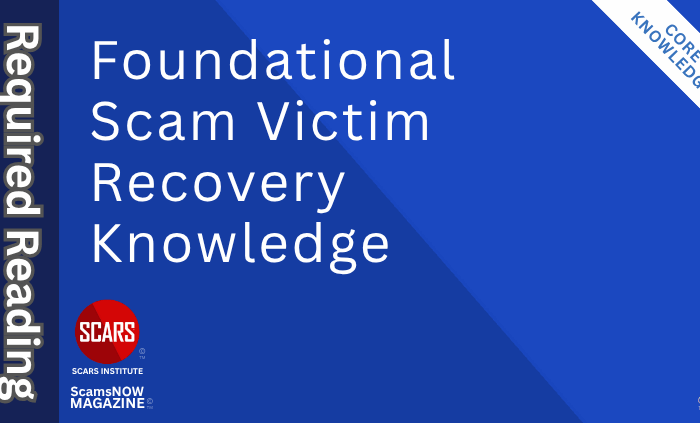
When Children Become Victims of Scams Too – A Guide for Parents
Parents As Scam Victims: Seeing and Supporting Children As Co-Victims
Primary Category: Scam Victim Recovery Psychology
Author:
• Tim McGuinness, Ph.D., DFin, MCPO, MAnth – Anthropologist, Scientist, Polymath, Director of the Society of Citizens Against Relationship Scams Inc.
• Vianey Gonzalez B.Sc(Psych) – Licensed Psychologist, Specialty in Crime Victim Trauma Therapy, Neuropsychologist, Certified Deception Professional, Psychology Advisory Panel & Director of the Society of Citizens Against Relationship Scams Inc.
Author Biographies Below
About This Article
When a scam strikes a family, children become co-victims, not bystanders. Safety returns when adults pair warmth with structure. Keep two lanes in view, the parent’s repair lane and the child’s growth lane. Restore small routines, tell the truth in simple language, and place responsibility where it belongs, on the offender, while adults lead repair. Younger children need brief reassurances and predictable days. Pre-teens need fairness they can see and a chance to help in age-fit ways. Teens need candor, privacy, clear roles, and firm digital boundaries. Guilt and shame will visit, yet steady messages, “You are safe and cared for,” and visible next steps calm the room. Schools, counselors, and community partners can align support so the child hears the same calm truth everywhere. If risk rises at home, act fast for safety, then reset. Recovery is not a straight line. It is many small returns to steadiness, celebrated out loud, “We are moving step by step, together.”
Note: This article is intended for informational purposes and does not replace professional medical advice. If you are experiencing distress, please consult a qualified mental health professional.

Parents As Scam Victims: Seeing and Supporting Children As Co-Victims
TRIGGER WARNING: This article explores a very difficult subject and how children can be victims of the scam too. If this becomes too emotional or overwhelming for parents, then take a pause and come back to it later.
Your Children are Victims Too!
When a scam strikes a household, the shock lands on parents first and then ripples through every corner of family life. Finances tighten, sleep thins, tempers shorten, and routines wobble. None of this signals poor parenting. It signals harm caused by a crime. Children absorb that harm even when adults try to shield them. They notice whispered money talks, closed doors, new rules, and the way faces change when a phone buzzes. They are not bystanders. They are secondary victims whose safety signals have been shaken.
A compassionate, practical stance helps everyone. The blame belongs to the offender. Repair belongs to the adults, and it can be shared. Children need calm truth in small pieces, predictable routines, and steady care. They also need parents who take their own feelings seriously. Guilt and shame are common after a scam; neither helps a child feel safe. What helps is modeling simple self-care, asking for support, and keeping family rhythms as consistent as circumstances allow.
Children at different ages show stress in different ways. Younger children often express worry through behavior and body complaints rather than words. Pre-teens want clear plans and fairness they can see. Teens look for honesty, privacy, and respect for their growing independence. Across ages, the essentials remain the same: warm presence, simple explanations that fit their world, and clear boundaries around money, screens, and daily life.
Parents should seek help from professionals. Helpful partners include pediatricians, school counselors, licensed child and family therapists with trauma training, community victim-assistance programs, social workers, faith or community leaders, and reputable nonprofit advocates for scam victims. Financial counselors and legal-aid services can help stabilize practical matters so parents have more bandwidth for children. When safety concerns or family conflict escalate, child-protective and crisis resources can be involved to keep everyone safe.
With patient support, families can steady the home, protect children from unnecessary burden, and help them keep growing while the adults work through recovery. Compassion and structure together make that possible.
The Household After a Scam: What Changes and Why It Matters
When a scam hits, the whole house feels it. Parents often move through a period of psychological shock that looks ordinary on the surface and heavy underneath. Sleep goes light or disappears. The mind replays chats and numbers at 2 a.m. Small decisions feel strangely hard because the big ones took so much. Many parents describe a mix of grief, shame, and hypervigilance. They check phones more, scan inboxes for threats, and tense at unknown numbers. None of this means the parent is failing. It means the nervous system is trying to protect the family after a breach of trust.
Practical shock arrives beside it. Money has changed, sometimes suddenly. Budgets tighten. A mortgage or rent may feel at risk. New tasks appear that do not care about fatigue: bank calls, fraud reports, credit freezes, police reports, password resets, and meetings with advisors. Some parents take extra shifts or a second job. Schedules shift. Routines that once held the day together get bumped by urgent to-dos. Even good steps can feel like too much when they stack up.
Children feel these waves even when nothing is said out loud. They notice clenched jaws, quiet dinners, closed doors, and new rules that cancel activities or limit screen time and spending. They notice a parent who is physically present but emotionally pulled inward. Younger children often translate this into behavior. They may become clingy, irritable, or somatic, with stomachaches and headaches. Pre-teens push for explanations and fairness. Teens may withdraw, fill in blanks with their own guesses, or take on worries that are not theirs to carry. This spillover is not because parents do not care. It is because stress leaks, and children read it well.
A simple organizing idea helps: two lanes. One lane belongs to the parent’s recovery. The other belongs to the child’s recovery. Both lanes need attention. They also need a few shared post-scam rules so they do not collide.
- Rule one is predictability. Even during paperwork and problem-solving, the household benefits from a basic daily rhythm. Keep wake, meals, and bedtime as steady as possible. Shorten routines if needed, do not remove them. Predictability is a safety signal children can feel.
- Rule two is a daily check-in that suits each age. Ten minutes after dinner or before bed works for many families. Younger kids get simple, concrete questions: what felt good, what felt hard, what do we need for tomorrow? Pre-teens add one choice they can make. Teens add privacy and respect for their schedule, with a standing time to connect that does not require a performance.
- Rule three is gentle truth in small pieces. Parents share enough to explain changes without transferring adult fear. “A crime affected our money. Adults are handling it. Your job is school, friends, and being a kid.” Details about amounts, banks, or blame stay in the parent lane and with professionals.
- Rule four is care for the parent as a skill, not a luxury. Short walks, paced breathing, and one supportive call a week are not indulgences. They are repairs that let a parent show up calmer. A calmer parent co-regulates a calmer child.
- Rule five is clear boundaries around money and screens. New limits are framed as safety, not punishment, and applied consistently. If an activity must pause, a date to review is set. Certainty, even about limits, feels kinder than surprises.
Why all of this matters is simple. Children measure safety by the steadiness of the adults and the structure of the day. When a parent tends to both lanes, the home becomes a place where hard things are named, help is welcomed, and everyone knows the next small step. That is how a family begins to steady after a scam.
Parents’ Guilt and Shame
Guilt rises fast after a scam because caretaking is wired into a parent’s identity. Many parents carry a private rule that says, “I should have seen this coming.” Visible fallout makes that rule feel louder. Bills change, plans shift, and relatives or friends sometimes offer unhelpful judgments that echo in the background. Hindsight bias adds fuel. Looking back, the path looks obvious in a way it never did in real time. In truth, offenders design contact to bypass ordinary defenses. They rehearse scripts, mirror values, and create urgency on purpose. Guilt often shows up here as a signal to repair what can be repaired. That is its helpful side. It becomes heavy when it turns into shame.
Shame narrows parenting. It pulls a parent inward and makes the room feel smaller. Silence becomes the default because every conversation seems like a test. Irritability spikes, not from lack of love, but from a nervous system stuck on alert. Secrecy grows in subtle ways: hiding mail, changing screens when children walk in, avoiding topics that might lead to questions. Age-appropriate conversations get postponed because the parent feels unworthy to lead them. Some parents overcorrect by loosening rules to relieve guilt or by tightening control to prove competence. Others retreat from school events, friends, or extended family to avoid imagined judgment. Shame does not just sting. It steals access to the very behaviors that protect children: calm presence, clear language, and steady limits.
Silence has a cost. When adults do not name what changed, children fill the gaps with stories that rarely help. Younger children often slide into self-blame or magical thinking. “If I had behaved better, we would still have the same house.” Pre-teens may assume a hidden disaster. “We must be broke forever.” Teens, skilled at pattern spotting, may draw catastrophic conclusions or decide the family cannot be trusted with the truth. In all ages, unexplained changes erode safety. Behavior follows. Some children cling. Some act out. Some go quiet and try to become invisible. A few try to become adults overnight. None of these reactions are misbehaviors in a moral sense. They are attempts to make sense of a story with missing chapters.
A gentle reframing helps the whole household exhale. The offender is responsible for the crime. The parent is responsible for repair steps and for modeling recovery. That division of labor matters. It returns accountability to action instead of self-attack. Modeling recovery looks like speaking plainly without oversharing, asking for help early, following a simple plan, and keeping boundaries that protect time, money, and attention. It also looks like correcting the inner narrator. “A criminal targeted me. I am taking steps to repair our situation. You are safe, and we will do this in pieces.”
Practical language supports the shift. Short, calm sentences travel well across ages.
- For younger children: “Something unfair happened to our money. The adults are fixing it. Your jobs stay the same: school, play, kindness.”
- For pre-teens: “A person tricked us. That is a crime. We have new rules while we solve it. You can ask any question, and I may say ‘I do not know yet’ or ‘That belongs to the adults.’”
- For teens: “We were defrauded. I am handling banks and reporting. Here is how our budget changes for a while. Your role is to keep your routines and come to me with worries so you are not carrying them alone.”
Two small habits reinforce the reframe. First, name a daily win out loud, even if it is tiny. “I made the bank call.” “We ate together.” “Bedtime was on time.” Children hear progress and borrow that steadiness. Second, set a boundary around self-criticism that children can see. “I am not going to call myself names. I will focus on the next step.” This teaches dignity without a lecture.
Parents can also expect waves. Guilt will visit again on hard days. Shame may try to close the door when a bill arrives or a question lands awkwardly. The task is not to never feel those states. The task is to notice them, reduce their volume, and return to the posture of repair. Warmth plus structure is that posture. Warmth says, “You matter and your feelings are valid.” Structure says, “Here is what changes and when we will review.” Children learn courage when they watch it. They also learn how to recover from mistakes by watching a parent recover from one.
Support from outside the home does not cancel responsibility. It strengthens it. A trusted advisor, a child-focused counselor, a support group for victims, and a clear plan with dates bring relief that shows up in tone of voice and patience at home. Those gains are not small. They are the quieter signs that shame is losing ground and that a parent is back in the role no criminal can take away: steady guide, honest teacher, and keeper of a hopeful timetable.
When Stress Turns Risky: Understanding Abuse and Neglect Risks
After a scam, unprocessed trauma can narrow a parent’s window of tolerance. Brains stay on alert, sleep is thin, and decision fatigue sets in. Under strain, some parents snap outward with harsh reactions, while others check out and go quiet. Neither pattern reflects a lack of love. Both reflect a nervous system running hot or shutting down. Without support, that stress can spill into the home as behaviors that frighten or neglect children.
Certain indicators signal rising risk. Escalating yelling that startles the room. Name-calling or sarcasm aimed at a child’s character. Frightening rules that change without warning. Any physical punishment. Emotional withdrawal that leaves children alone with big feelings for long stretches. In teens, risk also includes sudden surveillance without conversation, or punishments that remove food, sleep, or school. These are red flags, not moral verdicts. They are cues to slow down and add guardrails.
Practical guardrails help parents protect children while they stabilize. Families can agree on a cooling-off plan for heated moments. A simple, shared phrase gives everyone a way to pause. For example, a parent might say, “I feel flooded. I am taking five minutes in the kitchen and will come back at 6:30.” Children can use a safe word that means pause now, such as “yellow light.” Time-out belongs to the adult, not the child. A parent stepping away to breathe is a sign of strength. A prearranged support contact adds another layer. A neighbor, relative, or trusted friend can be on call for brief de-escalation check-ins. A text such as “Overwhelmed. Taking a break. Please call in ten” can interrupt a spiral.
Professionals who serve families work within mandatory reporting laws. Their first task is prevention. Clear education, early screening for caregiver overwhelm, and rapid referral to practical supports reduce the chance that stress turns into harm. When professionals do need to act, it is because safety must come first. Honest, respectful communication protects dignity while meeting legal duty.
Immediate help matters when danger rises at home. If anyone is at risk of harm, emergency services are the right call. Local crisis lines, child protection hotlines, and domestic violence services can guide short-term safety planning and connect families to respite, counseling, and financial or legal resources. In every case, the goal is the same: lower heat, restore steady routines, and protect attachment. Parents regain ground faster when safety is named clearly, help arrives early, and everyone in the household knows simple words that mean pause and reset.
How Children Understand and Respond — By Age
The following is a generalized guide to give parents an idea of what to expect and how to respond. If a parent has been scammed, we strongly recommend both family counseling and that the children have separate counseling.
Children Under 10
Young children read the room through bodies and routines. After a scam shakes the household, many become clingy, wake at night, or complain of tummy aches and headaches. Some slip backward in skills that had been solid, like toilet use or independent play. Fears widen. Monsters move from closets into daytime shadows. A child who once ran into school may now hold the doorframe and cry. None of this is misbehavior. It is a nervous system asking simple questions in the only language it knows: are we safe, who will take care of me, did I cause this.
Care begins with steady structure and warm, concrete words. Short phrases help more than explanations. A parent can kneel to eye level and say, “You are safe with me,” “Grownups are fixing the money problem,” “You did not cause this.” Keep bedtimes and mealtimes predictable. Use visual routines on the fridge. Offer choices that build agency, such as “Red shirt or blue shirt,” “Brush teeth now or after the story.” Co-regulation matters more than lectures. Sit close during play, match breathing, and invite sensory anchors like a weighted blanket or a warm bath.
Watch for sudden aggression, toileting regressions, separation panic at doors, and play themes about stealing or loss that repeat. These are cues to slow the pace and add support. Turn repetitive worry into a container. Create a “worry box,” write the worry on a slip, put it in, and tell the worry, “We will check you after dinner.” Read simple picture books about feelings. Notify teachers so the school can mirror the calm routines at home.
Keep adult conversations about finances and legal steps out of earshot. Children this age benefit from small truths delivered simply, then a return to normal play. End each day with a brief check-in, “One hard thing, one good thing, one hope for tomorrow.” Safety grows when words are gentle, touch is kind, and the day arrives in the order a child expects.
Pre-teens (10–12)
Pre-teens live at the edge of concrete and abstract thinking. After a scam, they often fixate on fairness. They want to know who did this, what happens now, whether friends will find out, and if it can happen again. Rumination shows up at bedtime. School focus dips. Stomachaches and headaches become frequent visitors. Many become curious about the details and ask questions that sound like cross-examination. They are not being rude. They are trying to rebuild a map of how the world works.
Meet them with calm facts, limits, and a path forward. Offer a short, honest summary and frame what comes next. A parent might say, “Someone lied to get our money. It was a crime. We are working with safe adults, and we are adjusting our budget while things get fixed.” Then invite questions in time-limited doses, “Ten minutes of questions, then we take a break.” Emphasize privacy without secrecy, “This is family information. If you want to tell a trusted adult, we can decide together.”
Watch for irritability, perfectionism that tightens into tears, withdrawal into screens, or spikes in sensitivity to peer opinions. These are signals to add structure and skill. Teach simple body tools, like a four count inhale and six count exhale, before homework. Use a worry journal that lives by the bed. Set homework blocks with short breaks so attention can reset. Involve them in practical repair steps that fit their age, such as meal planning, a small savings goal, or choosing free family activities. This builds agency and reduces helplessness.
Limit exposure to adult financial details and to online content that inflames fear. If they search, search together. End discussions with a stabilizing line, “Grownups are responsible for the big fixes. Your jobs are school, friends, sleep, and fun.” Pre-teens do better when they can ask, see that answers exist, and return to routines that affirm competence. Confidence returns through small responsibilities done well and through adults who keep promises on time.
Teens (13–18)
Teens think in systems and stories. After a scam, many feel anger at institutions or at the parent who was targeted. Others go quiet and carry private guilt, as if they should have noticed. Identity can wobble. Some take risks to reclaim control, while others clamp down with rigid rules for themselves. Advocacy impulses emerge. A teen might want to confront the offender online or post warnings. Underneath the stance are classic questions: why did this happen in our family, what does this mean for my future, who can be trusted now.
Respond with respect, partnership, and boundaries. Treat them as stakeholders, not as junior adults running the crisis. Offer a concise briefing and a role. “Here is what happened, here is what we are doing, here is what is not your job.” Validate feelings without debate: “Your anger makes sense,” “It is normal to question trust after a betrayal.” Invite collaboration where it is safe, such as helping evaluate online privacy, reviewing phishing risks together, or drafting a family tech plan. Set firm limits around vigilante behavior, “We will not contact the offender or post details. That can put us at risk. If you want to advocate, we can volunteer with a credible group when things settle.”
Watch for sleep inversion, grade swings, new substance use, self-harm signals, or online chasing of the offender. When red flags appear, widen the circle. Connect teens to a school counselor or a trauma-informed therapist. Normalize help, “Strong people use coaches. This is your coach for feelings and stress.” Keep home expectations clear and compassionate. Maintain chores, curfews, and school routines, and add flexibility where the load is heavy. Share timelines for decisions that affect teens, like moves or budget changes, so speculation does not fill the gaps.
Offer private space for grief. Teens often talk best in motion, during a drive, a walk, or while doing something side by side. Use consent checks: “Do you want ideas or an ear?” Close tough talks with a forward step they choose, “What would help this week feel steadier?” Trust rebuilds when teens are treated with honesty, given real tasks that matter, and protected from roles that do not belong to them. Steadiness grows when boundaries are firm, voices are heard, and the family keeps showing up together.
How to Talk About It — Age-Responsive Communication
Children steady themselves on clear words and consistent care. The approach remains simple across stages: tell the truth in plain language, name responsibility accurately, and end with a hopeful next step. Short sentences help overwhelmed minds absorb meaning. Present-tense reassurance matters: safety today, meals today, a plan for the next small interval. Specifics beat generalities. “Tonight we eat together.” “Tomorrow I meet with the bank.” Repetition is not a failure, it is a comfort. A parent can check understanding with gentle prompts: “What did you hear me say?” and invite questions over time: “We can talk about this again after dinner.” Accuracy about responsibility protects dignity: offenders choose the crime, caregivers choose the repairs. Every conversation closes with agency, even if small: “Your job is school and play.” “My job is the money plan and the helpers.”
Scripts and Boundaries — Under 10
Young children need a brief story and steady care. The message is simple: a trick happened, grownups are fixing grownup problems, and the child’s jobs remain the same. One clear script covers a lot: “Someone told a very convincing lie to our family. The grownups are working with helpers to fix what we can. You are safe and cared for.” Pair words with predictable routines. Post a picture schedule. Use bedtime anchors: “Two stories, one song, lights out.” When questions come, respond with calming facts in the present: “We are together. Your lunch is packed. I take care of the bills.”
Boundaries protect little ears and hearts. Avoid graphic details, blame of the child, and any financial numbers. Children this age do not need to hear about amounts, accounts, or specific tactics. If they ask, a parent can repeat and close: “That is a grownup part. My job is to fix the grownup part. Your job is to play and learn.” Normalize feelings: “It makes sense to feel wobbly.” Offer concrete co-regulation: shared breathing, a warm bath, a short walk holding hands. When fears repeat, create a container like a “worry box” and a daily “open and close” time. Teachers appreciate a heads-up so they can mirror calm structure and watch for regressions.
Scripts and Boundaries — Pre-teens (10–12)
Pre-teens sit between concrete facts and new abstractions. They do best with a basic explanation of the crime, a sketch of what the family is doing, and clarity about what will and will not change this month. A workable script sounds like: “A criminal group tricked me online. We have a plan with the bank and with helpers. We may cut back on extras for a while. You will still have food, school, and routines.” Then set a rhythm for questions: “Ten minutes now, more tomorrow after homework.”
They worry about fairness, peers, and recurrence. Address each briefly. “Who did this?” “Criminals who fool many people.” “Can it happen again?” “We are adding safety steps so it is much harder.” “Will friends find out?” “This is private family information. If you want to talk to a trusted adult, we decide together.”
Boundaries matter here too. Do not share private account details, revenge ideas, or ask them to keep secrets from other caregivers. Replace secrecy with privacy: “We do not keep secrets about safety. We do keep some information private.” Invite age-appropriate participation that builds agency without shifting burdens: choosing free family activities, helping plan meals, or joining a short “family cyber-safety check” once a week. End with a near-term step: “Tonight we charge devices in the kitchen.” “Saturday, we will set stronger passwords together.”
Scripts and Boundaries — Teens (13–18)
Teens value candor, roles, and respect. They can handle a clearer process, budget realities that affect them, and practical safety skills. The stance is collaborative without handing off adult work. A balanced opening sounds like: “I was targeted in a sophisticated fraud. I feel angry and embarrassed. I am working a plan. I will share the parts that affect you, and I will handle the rest with professionals. If you want to learn online safety skills with me, I would value that.”
Outline what changes and why, then define roles. “We are trimming extras for three months to stabilize. Your activities stay, rides stay, travel is paused. I will update you on dates that matter for you.” Offer concrete ways to contribute that do not turn a teen into a co-parent or investigator: reviewing privacy settings, enabling multifactor authentication, freezing credit where appropriate with consent, and practicing a family script for suspicious messages. Invite advocacy in safe channels later, not in the heat of the moment: “If you want to help others, we can look at credible volunteer options after we finish these first steps.”
Set limits on venting raw shame, interrogations, and vigilante urges. A parent can validate and draw lines at once: “Your anger makes sense. We will not contact the offender or post details. That can put us at risk.” “I will talk about decisions that affect you. I will not share screenshots or amounts.” Avoid turning a teen into an emotional caretaker: “I have adult support for my hard feelings. I do not need you to carry them.”
Close teen conversations with partnership and a plan: “Here is what I am doing this week. Here is what you can do. We check in Sunday night for ten minutes and adjust.” Offer language for peers that protects dignity: “If someone asks, you can say, ‘My family was hit by fraud. Adults are handling it. I am focusing on school and friends.’” Return to trust skill-building as a shared project: spotting phishing tells, verifying domains, slowing decisions, and refusing secrecy online.
Across ages, the rhythm holds: tell the truth simply, name the offender’s responsibility, set a small next step, and repeat under calm conditions. Children hear safety in steady words and see safety in steady follow-through.
Practical Stabilization for Children
Stability starts small. After a scam, children benefit most from predictable anchors that arrive on time, every time. Caregivers can restore a few routines first and let those rhythms do quiet work. Wake time at the same hour, a simple breakfast, school prep set out the night before, and lights out on schedule signal that the ground still holds. Visual cues help younger children. A picture chart by the door, shoes here, backpack there, lunchbox ready, turns mornings from negotiations into steps. When energy is low, “good enough” meals and a short walk after dinner often calm the room more than big plans.
Schools are partners in steadiness. A brief, discreet note to the counselor or homeroom teacher gives context and protects dignity. The message can be simple: “Our family is navigating a fraud incident. Please watch for fatigue and concentration dips. We will stay in touch.” Attendance plans, flexible deadlines, and quiet spaces for reset can be arranged when staff understand the why. Children are less likely to fall behind when adults coordinate early rather than waiting for crises.
Body skills make safety felt, not just said. Three child-friendly practices cover most needs.
- Belly breathing, one hand on the stomach, one on the chest, slow inhales through the nose and longer exhales through the mouth, downshifts arousal.
- Five senses grounding, name five things you see, four you feel, three you hear, two you smell, one you taste, returns attention to the present.
- Name the feeling games, pointing to a feelings chart or choosing a color that matches the mood, give language where words are hard.
- Short and often beats long and rare. Two minutes after school, two minutes before bed, and a quick reset when big feelings show up build capacity over time.
Screens deserve gentle structure. Doom scrolling, true crime clips, and scam content can flood anxious minds. Families can set a few clear guardrails that fit each age. Devices charge in the kitchen overnight. News is adult-led and time-limited. Social feeds are pruned to remove triggering accounts. When a child wants answers, caregivers can offer co-viewing with pause and explain breaks. “Let us stop here and check what is real.” For teens, a simple agreement helps, no links from strangers, no financial talk online, and a shared review of privacy settings once a week.
Money talk should be honest, brief, and matched to development. Younger children only need to know what stays the same and what a caregiver handles. “Grownups are fixing grownup problems. You will have meals, school, and care.” Pre-teens can hear about temporary cutbacks with time frames: “We are pausing extras for two months while we work with the bank.” Teens can receive a clear sketch of budget realities that affect them, plus a predictable allowance or spending plan where possible. Specific limits reduce worry. “We are choosing one sport this season. We will revisit in September.” Predictability matters more than amounts. When children can forecast their days, their nervous systems spend less energy bracing, and more energy returns to learning, play, and rest.
Practical stabilization is not grand. It is a handful of steady habits, shared language for feelings, aligned adults at home and school, and right-sized transparency about money. Those pieces teach a durable lesson: the world can wobble and still hold.
Counseling and Child-Focused Support
Children benefit from counseling even when they seem fine. Many manage on the surface while their bodies carry the load in quieter ways, such as headaches, stomach aches, sleep changes, clinginess, irritability, and perfectionism. Early support shortens the arc of distress, gives names to feelings, and teaches concrete skills before worry hardens into habits. Counseling is not a verdict on parenting. It is a protective resource that helps a child regain confidence while the household repairs.
For younger children, play is the language. Ask about child-centered play therapy or integrative play approaches that let themes of safety, separation, and control appear in stories, drawings, and games. Skilled therapists mirror and gently scaffold. A child who cannot say “I feel scared at bedtime” may show it with a worried superhero who never sleeps. The work is to help feelings move and to install simple routines that the family can sustain.
For school-age youth, trauma-focused cognitive behavioral methods are often a good fit. Therapists teach how thoughts, feelings, and body states link together, then practice skills to lower the level of alarm. Expect brief, practical homework such as a calming breath drill, a thought-check card, or a two-step plan for school worries. The tone is hopeful and specific. “When your tummy hurts before school, let us try five slow breaths and one sentence that reminds your brain you are safe.”
Teens tend to respond to skills they can own. Ask about structured, skills-based therapies that include emotion regulation, distress tolerance, and values-guided actions. Short, focused plans work best, one or two goals, better sleep, fewer conflict blowups, safer online habits. Collaboration matters. “You keep the steering wheel. I will bring tools.” The therapist should respect privacy while keeping safety plans clear.
Family sessions can align language and lower blame. A brief joint meeting helps everyone hear the same message: “A criminal harmed our family. The grownups are handling the money and the calls. Your jobs are school, friends, and practicing a few calming skills.” Small repairs happen when a parent names responsibility accurately and models recovery steps. Siblings can attend together or separately, depending on age and dynamics.
A clear briefing helps a counselor start strong. Share a short timeline, the date the scam was discovered, immediate changes at home, and any moves, schedule shifts, or school notes. Add observed changes in the child, sleep, appetite, somatic complaints, mood, school performance, and friendship patterns. State specific worries and hopes. “Nightmares three times a week.” “Worried about self-blame.” “Goal is one calming skill at bedtime and less stomach pain on school mornings.” Keep copies of any school notices or pediatrician notes. Counselors do not need financial details or graphic content. Safety information is shared; private adult material stays with adults.
Access routes are broader than many expect. School counselors can coordinate check-ins, classroom supports, and referrals. Community clinics offer sliding-scale services and often have child specialists. Telehealth widens reach for families with tight schedules or limited transportation; many children engage well from a quiet room at home. Where culture or language matters, ask deliberately for a provider who shares or understands the family’s background. Feeling seen increases engagement. If waitlists are long, request a brief skills group, a parent coaching slot, or a bridge session for sleep and worry while you wait for full services.
The measure of good child-focused support is practical: more ease in the body, clearer words for feelings, steadier routines, and fewer explosions or collapses. A child who learns to say “I feel wobbly; can we do our breathing?” is moving from being carried by events to carrying a tool. That shift helps the whole household heal together.
Communication Pitfalls and How to Avoid Them
Over-sharing or under-sharing. Children need enough truth to feel oriented and safe, not the adult details that create burden. Over-sharing transfers worry. Under-sharing invites imagination to fill gaps with fear. A steady middle works best: a brief, accurate headline, what is being done, and what stays the same. A parent might say, “A criminal tricked our family. Grownups are working with helpers. You are safe. Your jobs are school, friends, and home routines.” If questions come, answer what was asked and stop there. Revisit the topic later rather than pouring everything into one talk.
Recruiting the child as emotional caregiver. After a scam, parents can feel emptied out. It is easy to lean on the nearest kind face. Children are comforted when adults are comforted, but they are not responsible for holding adult pain. Signals of role reversal include a child checking on the parent repeatedly or feeling guilty for having fun. A protective line helps: “Thank you for caring. I will talk about the hard parts with grownups who help me. You do not have to carry this.” If big emotion rises, take a brief time-out and return when steady.
Mixed messages between caregivers or relatives. Confusion grows when one adult minimizes while another dramatizes. Aligning on two or three key sentences prevents whiplash. Shared language might be, “A crime happened. We are fixing what we can. The children are safe and will have what they need.” If a relative shames or lectures, the boundary is calm and clear: “We are using supportive language at home. Please follow our script or we will pause this conversation.”
Shaming or moralizing about the crime. Shame freezes learning. Comments like “We should have known” or “This is what happens when you trust people” teach fear, not wisdom. Replace moralizing with skill building: “Criminals use very smart tricks. We are learning safer habits together.” When a child asks why it happened, keep responsibility accurate: “The offender chose to lie. We are choosing to repair.”
Promising outcomes that cannot be guaranteed. Children listen closely for absolutes. Avoid “Everything will be back to normal next month.” Choose promises that can be kept: presence, effort, and a plan. For example, “I cannot promise dates, but I can promise that you will be cared for, and that I will tell you what changes as soon as I know.” If a prior promise becomes impossible, model repair: “I said this would be sorted by now. That changed. Here is what we will do this week.”
Talking About Money, Housing, and Hard Changes
Naming change without catastrophizing. Children feel safer when change is named plainly, not hidden and not dramatized. A simple frame works: what is changing, what is not, and the next review point. “We are spending less on extras for a while. Food, school, and routines stay the same. We will check our plan in two weeks.” Use present-tense reassurance and avoid worst-case futures.
How to involve children in choices that affect them, not in adult decisions. Invite voice where it empowers and excludes adult burdens. A parent might say, “We need to choose one activity to pause this season. Which one would you prefer to keep?” Do not ask children to solve budgets, call banks, or evaluate legal steps. Offer two or three real options related to their world and honor the selection.
Scripts for Downsizing, Moving, or Delaying Activities.
-
- Downsizing: “Our home costs more than our new plan allows. We are choosing a smaller place that we can manage. Your room will be yours. We will bring what matters most and keep our routines.”
- Moving: “We will move at the end of next month. Your school will stay the same, and we will visit the new neighborhood together. Let us make a list of things that help a new place feel like home.”
- Delaying activities: “Soccer fees are not in our plan this term. We will look again next season. Let us pick a free practice plan at the park on Saturdays to keep your skills up.”
Preserving dignity during cutbacks through family rituals and low-cost joys. Loss does not have to mean constant deprivation. Small rituals tell the nervous system that life is still good. Hold a weekly pancake night. Take library walks and choose a shared audiobook. Plan a backyard picnic, a movie blanket on the floor, or a family stretch break before bed. Invite children to co-create a list called “Things that feel good and cost little.” Post it where everyone can see it. Keep a simple allowance or chore credit system if possible, even a very small one, because predictable autonomy reduces worry. When a child asks for something the budget cannot hold, answer with respect: “I hear that you want it. It is not in our plan right now. We can put it on a wish list and look again in three months.” Dignity grows when limits are steady, language is kind, and joy is practiced on purpose.
When communication is balanced, responsibilities are clear, and changes are named without doom, children adapt more quickly. The home begins to feel navigable again. Parents are not expected to be perfect. They are asked to be present, truthful at the right level, and willing to repair when a conversation goes wrong. That steadiness is the anchor everyone can hold.
School, Community, and Digital Life
Coordinating with teachers, coaches, and community leaders.
Children steady or stabilize faster when the adults around them work from the same map. Parents can brief a school counselor, homeroom teacher, coach, or faith leader with a short, need-to-know summary: what changed, what the child might show (tired, distracted, tearful), and what helps (quiet check-ins, flexible deadlines, predictable routines). A simple script keeps dignity intact: “Our family is handling a crime that affected our finances and stress. Please watch for concentration dips and let us know early. We are not asking for special treatment, just steady communication.” Coaches and activity leaders can adjust attendance or fees without spotlighting the child. Community and faith leaders can reinforce supportive language and redirect gossip kindly.
Managing rumors and privacy.
Curiosity spreads quickly in schools and small communities. Families do well to agree on a brief public line that protects privacy and stops speculation. For adults: “We’re working through a private legal matter and staying focused on the kids’ routines.” For children: “Something hard happened at home. I’m okay and don’t want to talk about it at school.” If rumors start, the school can help by reminding students of respect policies and by offering a staff point person for concerns. Online, lock down privacy settings, audit followers, and pause public posts that invite questions. Teach a simple rule before sharing: stop, check audience, share only what future-you would be comfortable reading aloud. Encourage children to route nosy questions to a trusted adult rather than defending the family story.
Teen digital boundaries after a scam.
Teens often want to act, expose, or “fix.” That energy needs a frame so it does not turn risky. Name clear lines: no confronting suspected offenders, no doxxing, no revenge posts, no bait accounts, and no sharing screenshots of case details. Replace impulse with procedure: document, report, block, and let adults and platforms handle enforcement. A parent can say, “I respect your urge to protect us. The safest way is to collect evidence, report through official channels, and let me or another adult submit it.” Add practical safety: unique passwords, app-based multifactor authentication, location sharing off by default, private accounts, and careful friend lists. Suggest one shared learning project that channels advocacy safely, such as helping a counselor post platform reporting links or preparing a short internet-safety presentation with a teacher’s guidance. When group chats flare with rumor or blame, offer an exit line teens can use: “I’m not discussing this here. If you’re worried about me, text me separately.” Keep night boundaries around screens, especially after upsetting content, so bodies can settle. With coordinated adults, a calm privacy plan, and firm online guardrails, teens stay protected while still feeling included and useful.
Special Considerations
Single-parent households and limited caregiver bandwidth.
When one adult holds everything, recovery tasks stack quickly. It helps to simplify the day. Keep a short list of must-do items and postpone the rest. Identify one backup adult who can handle pickups or bedtime once a week. Schools and community centers can help with aftercare and meal programs. A parent can say to a child, “My schedule is tight right now. You are safe. Here is today’s plan, and here is who helps if I am running late.” Predictability lowers anxiety for both.
Neurodivergent children who need concrete tools.
Many autistic and ADHD children calm faster with visuals, sensory supports, and literal language. Replace abstract reassurances with clear pictures and steps. Use a simple schedule strip for mornings and evenings, a feelings chart, and a short social story about “a trick that happened to our family” with two or three safe helpers named. Offer sensory breaks before hard talks: headphones, weighted lap pad, movement. A parent can say, “A criminal told us a lie. Grown-ups are fixing the money parts. Your jobs are school, play, and sleep. If this feels loud inside, we take a break, then talk again.” Consistency and options reduce overload.
Cultural values that shape conversations about shame and money.
Families honor traditions about privacy, respect for elders, and saving face. These values can protect dignity and can also make silence heavier. Choose language that fits the family’s frame while keeping truth intact. For example, “Someone took advantage of our trust. We will handle it together with prudence and help from trusted elders.” In communities where communal support is expected, identify one or two discreet advisors and limit details to need-to-know. Emphasize stewardship, responsibility, and care for children. The aim is honest, culturally fluent messages that reduce blame, not public confessions that invite gossip.
Separated or blended families aligning messages and rules.
Children steady when caregivers coordinate. Even with tension between adults, a short common script protects the child. Agree on what will be said about the scam, what changes for the child this month, and who fields school questions. Share only what affects schedules, safety, and finances that touch the child. A co-parent can text, “Let’s use one line with the kids: ‘An online crime affected our budget. You are safe. School and routines continue. Adults are handling the rest.’ I will tell the counselor the same.” Avoid turning the story into a custody argument. If conflict rises, use a mediator or parenting coordinator to keep messages aligned and to prevent children from carrying adult stress. Consistent words and predictable rules across homes make recovery easier for everyone.
Warning Signs That Require Immediate Action
Some signals mean the family needs help today. The aim is safety first, judgment later. Taking quick, clear steps protects children and steadies parents.
Talk of self-harm, unsafe behavior, or threats in the home. Immediate red flags include statements about wanting to die, not wanting to be here, or being a burden; mention of a plan or access to means; giving away prized items; sudden, risky behavior such as reckless driving, disappearing at night, or substance binges; threats to hurt someone at home; and escalating fights that frighten siblings. When any of these appear, the safest response is to act now rather than watch and wait.
Signs of neglect, escalating aggression, or unsafe discipline. Unprocessed trauma can pull a household off course. Indicators that children are not safe enough include frequent missed meals, lack of supervision for age, untreated medical needs, utilities shut off without a plan, a home environment that feels chaotic or frightening, harsh name-calling, shaming rules, hitting, or punishments that isolate a child for long periods. These patterns harm children and also place parents at risk of legal trouble. Early help is protective for everyone.
What to do today. If danger feels immediate, use emergency services. In the United States, call 911. For acute emotional crises, call or text 988 for the Suicide and Crisis Lifeline. If outside the United States, use your country’s emergency number or a national crisis line. If there is injury, active self-harm, or a credible plan, go to urgent care or an emergency department. If the home is too heated to calm, move to a pre-identified safe place such as a grandparent, aunt, or trusted neighbor. A parent can use simple scripts: “I need help right now. We are not safe to stay home this evening.” or “We are taking a break to calm and will return when it is safe.” Arrange a short stay, not a permanent move, so the step feels doable.
Create quick guardrails. Remove or lock away medications, alcohol, sharps, cords, and car keys. Secure any firearms in locked storage according to local law. Set a temporary quiet rule for the home and postpone hard conversations until everyone is calmer. Text the school counselor to ask for a check-in the next school day. Let one trusted adult know the plan for the next twenty-four hours.
How to document and why it helps. Write down what happened using neutral, observable language, not interpretations. Note the date, time, what was said, what was done, and who was present. Save relevant screenshots or messages if it can be done safely. Record calls or visits with crisis lines, police, urgent care, school, or therapists, including names and case numbers. Documentation supports accurate care, reduces the need to retell painful details, and shows a pattern if services or courts become involved. It also helps parents see progress when the heat of the moment fades.
After the immediate step. Schedule follow-ups with a pediatrician or child therapist and, when possible, a parent’s counselor. Tell children the safety headline once everyone is calm: “We had a scary moment. We got help. We are safe now and we have a plan for today.” Quick action, clear words, and steady follow-through protect children and restore a parent’s footing.
A Recovery Timeline for the Family
First 72 hours.
The immediate task is to stop financial bleed and create calm anchors for children. Parents contact banks, payment apps, and platforms to freeze transactions and change credentials. At home, they keep the day simple: normal wake time, meals, and bedtime. One steady sentence helps when questions arise: “We are safe, the grown-ups are handling the money problem, and today your job is school and play.” The school counselor is notified so teachers can watch for changes and offer small supports.
First month.
The household shifts from crisis to stabilization. Routines are rebuilt, including homework time, lights out, and weekend planning. First counseling appointments are scheduled for the parent and, when appropriate, for the child. A brief, age-fit budget talk sets expectations without fear: “We will press pause on extras this month. You will have what you need. We will review together in four weeks.” Small, repeatable coping skills are practiced as a family, such as belly breathing before dinner.
Months two to six.
Skills are refined and expectations adjusted. Parents track what helps each child settle, reduce overcommitment, and plan positive milestones that are not tied to spending: a game night, a library visit, a picnic, a shared project. Progress is named aloud: “We handled a tough week and stayed kind. That matters.” The parent’s recovery steps continue in the background with referrals, paperwork, and supervision or support for the caregiver.
Slips and resets.
Setbacks happen. A bill arrives, a memory spikes, a night goes poorly. The parent models repair without scaring children by naming the frame and the plan: “I was more tense today. I am taking a short break to reset, and we are still okay.” If a promise must change, the update is concrete and time-bound: “We will reschedule the outing for next Saturday. Thank you for your patience.” Each reset teaches that recovery is a path with turns, not a test to pass in one try.
Conclusion
Families recover when care and structure travel together. A parent who was targeted by a crime can steady the home by keeping two lanes in view: the parent’s lane for repair and the child’s lane for growth. Small anchors matter most. Wake times, meals, homework, and lights out signal safety more than speeches do. Calm truth in short sentences protects dignity and reduces fear. The blame belongs to the offender. Responsibility for repair belongs to the adults, shared with trusted helpers.
Children remain co-victims, not bystanders. They read faces, routines, and tone. Younger children need simple reassurances and predictable rhythms. Pre-teens need fairness they can see and chances to help in age-appropriate ways. Teens need candor, respect for privacy, clear roles, and firm guardrails around advocacy and online behavior. Across ages, the language stays steady: “A criminal harmed our family. Adults are handling the grown-up parts. You are safe and cared for.”
Guilt and shame will visit. They do not get to run the house. When a parent names feelings, takes short breaks, and returns with a plan, children learn how to recover without fear. Outside support is strength, not failure. Trauma-informed counseling for children, therapy or peer support for adults, and brief sessions with financial guides turn chaos into steps. Professionals, schools, and community leaders can align messages so the child hears the same calm truth in every setting.
Safety comes first. If risk rises at home, quick action and clear words protect everyone. Document, call for help, and reset. When setbacks arrive, repair them in plain sight. “Today was rough. I am taking a pause, and we are okay.” Recovery is not a straight line. It is a series of small returns to steadiness. Children remember the rhythm of those returns.
The path forward is patient and practical. Tell the truth kindly. Keep routines. Ask for help early. Celebrate small wins. “We are moving step by step, together.”
Additional Information
Parent Skills That Help Children Most
Regulate Before You Relate
Children borrow a parent’s nervous system. When the adult steadies first, the message is safety. A brief reset is enough: feet on the floor, one hand on the chest, a slow exhale to a count of six, and a quiet scan of the room to name five ordinary objects. Then the conversation begins. A helpful inner cue is “Settle my body, then choose my words.” Before hard talks, the parent takes sixty seconds, recalls the goal, and keeps sentences short and present tense, like “You are safe. Grown-ups are handling money. Here is today’s plan.” Regulating first prevents sharpness, reduces looping, and models self-control children can copy.
Repair After Ruptures
Stress tests every household. If a parent snaps, the repair matters more than perfection. Effective repair has four parts: own the behavior, name the impact, state the plan, and invite a response. For example, “I raised my voice. That was scary. I am going to take a short break and try again. Is there anything you want me to know?” No excuses, no lectures. The parent returns later with consistency: “Thank you for telling me how that felt. I am working on calmer mornings.” Each repair teaches that relationships bend and then mend, which lowers a child’s fear that conflict equals danger.
Name Strengths and Effort
After a family shock, children watch adults for clues about who they are now. Strength-based language guards identity. Praise stays specific and process-focused: “You kept trying on that math problem,” “You told me when you felt worried,” “You were gentle with your sibling during cleanup.” The aim is to help children see themselves as capable participants in recovery, not fragile byproducts of it. When setbacks happen, the frame is growth: “This was a hard morning, and you used your breathing,” “You asked for help at the right time.” Over time, children internalize a steady story: difficult things happen, and they have skills.
Protect the Adult Channel
Even in separation or blended families, children should not be the bridge. Adult conversations live in adult spaces. Caregivers keep planning talks offstage, align on key messages, and settle disagreements privately. A shared script prevents mixed signals: “Here is what both homes will say about the scam,” “Here is what both homes will do about screens.” When a child tries to mediate, the response stays kind and firm: “This is for the adults to sort. You do not have to carry it.” Practical tools help, such as a co-parent calendar, a weekly check-in by text or email, and a rule to pause sensitive topics until emotions cool. Protecting the adult channel reduces triangulation, lowers a child’s anxiety, and preserves the sense that the grown-ups are steering.
Bringing It Together
Across these skills runs one theme: calm first, clarity next, connection always. Parents who regulate before relating, repair when they miss, name strengths in daily effort, and keep adult communication clean create conditions where children feel held and learn how to hold themselves.
Divorced Parents: Custody, Support, and Sudden Financial Shock
When parents are divorced, a scam not only drains money, but it also strains court orders, co-parenting trust, and children’s stability. If the scammed parent has primary custody, the immediate risk is disruption of housing, routines, and school. If that parent pays support, the risk is falling out of compliance. Both situations call for fast, calm coordination.
Immediate legal priorities
The first call belongs with a licensed family law attorney. Early advice protects children and prevents avoidable legal trouble. Counsel can review current orders, file for temporary relief, and advise on documentation. In many jurisdictions, adjustments to child support or parenting-time logistics are considered from the date a petition is filed, not the date the crisis began, which is why speed matters. Until an order changes, parents are generally expected to comply as written. Stopping payments without court guidance invites penalties. An attorney can also recommend mediation for short-term problem-solving.
Child support and temporary relief
If the paying parent cannot meet the full amount due to scam losses or job interruption, counsel can request a temporary modification, a payment plan, or a brief abatement tied to verified hardship. The aim is to show good faith, document the crime, and avoid contempt. Where a child support agency is involved, prompt contact helps set expectations and may open administrative options. The message to the other parent should be respectful and specific about interim steps. A parent might say: “I am meeting with counsel to file for a temporary adjustment based on a documented crime. I remain committed to our child’s needs and will follow the process.”
Custody stability and housing
For a primary-custody parent, stability is the court’s lens. Before changing schools, relocating, or modifying schedules, consult counsel. Courts look for calm continuity. If housing is at risk, the legal team can explore temporary orders that preserve school placement, emergency assistance, or short-term family support. A parent might say to the co-parent, “Our child’s routines are my priority. I will keep school, bedtime, and activities steady while I work a legal plan. I will update you after I speak with counsel.”
Co-parent communication
Scams inflame shame and defensiveness, which can spill into co-parenting. Keep messages brief, factual, and child-focused. Avoid blame or investigative detail. Use the parenting app or agreed channel. A parent might say: “I was the victim of an online crime. I am handling it with professionals. Here is what affects our child this week: transportation unchanged, lunch account funded, therapy appointment scheduled.”
Documentation and legal coordination
Save reports, bank correspondence, and law-enforcement intake numbers. Provide counsel a clear timeline, current orders, and any communication that affects exchanges, expenses, or decision-making. If the other parent raises concerns, invite them to speak through counsel or mediation rather than escalating by text.
Safety and privacy considerations
If offenders harass the family, counsel can advise on protective orders, address confidentiality of addresses and schools, and coordinate with law enforcement. Digital safety for children remains essential. Co-parents should align on boundaries for devices and social media during the recovery period.
Bottom line
The offender is responsible for the crime. The parents are responsible for rapid, lawful repairs that protect children’s stability. Early legal guidance, steady communication, and child-first decisions keep the family on the safest path while the financial case moves through proper channels.
When Parents Need More Help
Signs the parent’s trauma is overcrowding the home
There are moments when a parent’s pain begins to set the pace for everyone. Common signs include persistent hypervigilance, startle responses, and sleep that never restores. Decision fatigue shows up as stalled choices and missed deadlines. Irritability stretches longer, patience shortens, and small conflicts escalate quickly. Silence can take over family meals. The parent avoids calls, skips school emails, or withdraws from friends who once steadied the week. Somatic strain appears as headaches, chest tightness, stomach trouble, or a racing heart through ordinary tasks. Children may start to tiptoe, overperform, or shut down to avoid adding to the load. When the home orbits the parent’s symptoms more than the family’s routines, it is time to widen the support team.
How to seek adult therapy, support groups, and financial counseling
A practical first step is a short list with three lanes. Lane one is emotional care. A parent can contact a trauma informed therapist, ask about approaches that teach skills, and request an intake focused on sleep, anger, shame, and decision fatigue. If cost or access is a barrier, look to community clinics, telehealth, or faith and cultural centers that host sliding scale services. Lane two is peer support. Moderated groups for scam victims reduce isolation and provide simple practices that can be used at home. Joining a group also gives the co parent or trusted relative a predictable window to hold the household steady. Lane three is financial clarity. Brief sessions with a nonprofit credit counselor or a pro bono financial coach help translate chaos into a short action plan. Prioritize stop the bleed steps, creditor communication, and a basic budget that preserves housing, food, utilities, school, and transport. When calling any provider, a parent can say: “I was the victim of an online crime. I am seeking short term help to stabilize my household and learn specific skills. What openings do you have for an intake.” Keep records of appointments, contacts, and agreed next steps in one folder so follow through is easier on hard days.
Why accepting help models strength for children
Children learn more from what adults practice than from what they promise. When a parent reaches for counseling, attends a support group, or meets with a financial guide, the child sees responsibility in motion. The message is simple. People can be hurt and also get help. That observation lowers shame, builds hope, and gives language a child can use when they face their own struggles. A parent can name this aloud in age fitting words. “I am talking with a helper to learn how to handle this better.” “Grown ups need support too, and I am getting mine.” Accepting help also resets the family’s balance. The parent returns with steadier sleep, clearer boundaries, and a plan that is sized to the week, not to the whole future. That steadiness makes the home feel safer. It also gives permission for children to ask for their own supports, like school counseling or a check in with a mentor. Seeking help is not a detour from strength. It is the route back to it, and it shows children that courage looks like reaching out, telling the truth about what is hard, and practicing small steps until the day feels livable again.
Glossary
- Co-victim — a child impacted by a parent’s scam through shaken safety, routines, and attachment.
- Two lanes — a family map that tracks the parent’s repair lane and the child’s growth lane.
- Calm truth — short, clear statements about what changed and what stays the same.
- Present-tense reassurance — concrete safety now, like you have meals, school, and care today.
- Age-fit language — explanations matched to a child’s developmental level.
- Privacy, not secrecy — protecting information without asking children to hide unsafe secrets.
- Predictable routines — steady wake, meals, homework, and lights-out that signal safety.
- Co-regulation — a child settling because an adult is steady and predictable.
- Window of tolerance — the range where feelings are manageable without flooding or shutdown.
- Hypervigilance — constant scanning for threat after betrayal or fraud.
- Decision fatigue — exhaustion from many hard choices that makes small choices harder.
- Gentle scripts — ready phrases that protect dignity, such as someone told a convincing lie.
- Boundary line — a clear limit that protects time, money, attention, or privacy.
- Family check-in — a brief daily touchpoint, like one hard, one good, one plan.
- Worry box — a container ritual to park worries and revisit at a set time.
- Belly breathing — slow inhale, longer exhale to downshift arousal.
- Five-senses grounding — naming things seen, felt, heard, smelled, and tasted to return to now.
- Name-the-feeling — simple emotion labeling using words, charts, or colors.
- Screen hygiene — guardrails that limit doom-scrolling and triggering content.
- Age-fit transparency — money talk at a level that informs without burdening.
- Allowance predictability — small, steady funds or credits that restore agency.
- Review date — a set time to revisit cutbacks or rules to reduce uncertainty.
- Repair after rupture — owning a misstep and resetting the relationship.
- Cooling-off plan — a pre-agreed pause for heated moments.
- Safe word — a child’s cue that means pause now to prevent escalation.
- Parent time-out — the adult steps away to regulate; not a punishment for the child.
- Guardrails — proactive safety measures that prevent predictable problems.
- Documentation — neutral notes, dates, and screenshots that support care and reporting.
- Crisis lines — immediate supports (e.g., 988 in the U.S.) for acute emotional risk.
- Mandated reporting — a professional duty to act when child safety is in question.
- Stabilization — early steps that reduce chaos and restore daily anchors.
- Stepped care — matching help to need, from school supports to specialized therapy.
- Play therapy — child-led therapeutic play that expresses and resolves feelings.
- Trauma-focused CBT — structured skills for school-age youth linking thoughts, feelings, and body.
- Skills-based therapy — practical teen tools for emotion regulation and safe choices.
- Family alignment — caregivers using the same script and rules across homes.
- Culturally fluent messaging — truthful communication shaped to family values and language.
- Neurodivergent supports — visuals, routines, and sensory tools for autistic/ADHD children.
- Rumor management — brief public lines that protect privacy and halt speculation.
- Digital boundaries — limits that block vigilante behavior and protect privacy online.
- School briefing — discreet info for staff on what changed and what helps.
- Dignity language — words that separate the crime from a person’s worth.
- Agency — the child’s felt ability to act through small, real choices.
- Daily win — a tiny success named aloud to build momentum.
- Slips and resets — expecting setbacks and modeling return to steadiness.
- Advocacy safely — channeling teen energy into credible, adult-guided efforts.
- Support map — a written list of helpers, contacts, and times for high-stress days.
- Public line — a standard sentence for outsiders that protects family privacy.
- Consent check — asking do you want ideas or an ear before advising.
- Shame disruptor — reframing blame accurately, e.g., the offender is responsible; we repair.
Author Biographies
-/ 30 /-
What do you think about this?
Please share your thoughts in a comment below!
One Comment
Leave A Comment
Important Information for New Scam Victims
- Please visit www.ScamVictimsSupport.org – a SCARS Website for New Scam Victims & Sextortion Victims.
- SCARS Institute now offers its free, safe, and private Scam Survivor’s Support Community at www.SCARScommunity.org – this is not on a social media platform, it is our own safe & secure platform created by the SCARS Institute especially for scam victims & survivors.
- SCARS Institute now offers a free recovery learning program at www.SCARSeducation.org.
- Please visit www.ScamPsychology.org – to more fully understand the psychological concepts involved in scams and scam victim recovery.
If you are looking for local trauma counselors, please visit counseling.AgainstScams.org
If you need to speak with someone now, you can dial 988 or find phone numbers for crisis hotlines all around the world here: www.opencounseling.com/suicide-hotlines
Statement About Victim Blaming
Some of our articles discuss various aspects of victims. This is both about better understanding victims (the science of victimology) and their behaviors and psychology. This helps us to educate victims/survivors about why these crimes happened and not to blame themselves, better develop recovery programs, and help victims avoid scams in the future. At times, this may sound like blaming the victim, but it does not blame scam victims; we are simply explaining the hows and whys of the experience victims have.
These articles, about the Psychology of Scams or Victim Psychology – meaning that all humans have psychological or cognitive characteristics in common that can either be exploited or work against us – help us all to understand the unique challenges victims face before, during, and after scams, fraud, or cybercrimes. These sometimes talk about some of the vulnerabilities the scammers exploit. Victims rarely have control of them or are even aware of them, until something like a scam happens, and then they can learn how their mind works and how to overcome these mechanisms.
Articles like these help victims and others understand these processes and how to help prevent them from being exploited again or to help them recover more easily by understanding their post-scam behaviors. Learn more about the Psychology of Scams at www.ScamPsychology.org
SCARS INSTITUTE RESOURCES:
If You Have Been Victimized By A Scam Or Cybercrime
♦ If you are a victim of scams, go to www.ScamVictimsSupport.org for real knowledge and help
♦ SCARS Institute now offers its free, safe, and private Scam Survivor’s Support Community at www.SCARScommunity.org/register – this is not on a social media platform, it is our own safe & secure platform created by the SCARS Institute especially for scam victims & survivors.
♦ Enroll in SCARS Scam Survivor’s School now at www.SCARSeducation.org
♦ To report criminals, visit https://reporting.AgainstScams.org – we will NEVER give your data to money recovery companies like some do!
♦ Follow us and find our podcasts, webinars, and helpful videos on YouTube: https://www.youtube.com/@RomancescamsNowcom
♦ Learn about the Psychology of Scams at www.ScamPsychology.org
♦ Dig deeper into the reality of scams, fraud, and cybercrime at www.ScamsNOW.com and www.RomanceScamsNOW.com
♦ Scam Survivor’s Stories: www.ScamSurvivorStories.org
♦ For Scam Victim Advocates visit www.ScamVictimsAdvocates.org
♦ See more scammer photos on www.ScammerPhotos.com
You can also find the SCARS Institute’s knowledge and information on Facebook, Instagram, X, LinkedIn, and TruthSocial
Psychology Disclaimer:
All articles about psychology and the human brain on this website are for information & education only
The information provided in this and other SCARS articles are intended for educational and self-help purposes only and should not be construed as a substitute for professional therapy or counseling.
Note about Mindfulness: Mindfulness practices have the potential to create psychological distress for some individuals. Please consult a mental health professional or experienced meditation instructor for guidance should you encounter difficulties.
While any self-help techniques outlined herein may be beneficial for scam victims seeking to recover from their experience and move towards recovery, it is important to consult with a qualified mental health professional before initiating any course of action. Each individual’s experience and needs are unique, and what works for one person may not be suitable for another.
Additionally, any approach may not be appropriate for individuals with certain pre-existing mental health conditions or trauma histories. It is advisable to seek guidance from a licensed therapist or counselor who can provide personalized support, guidance, and treatment tailored to your specific needs.
If you are experiencing significant distress or emotional difficulties related to a scam or other traumatic event, please consult your doctor or mental health provider for appropriate care and support.
Also read our SCARS Institute Statement about Professional Care for Scam Victims – click here
If you are in crisis, feeling desperate, or in despair, please call 988 or your local crisis hotline – international numbers here.
More ScamsNOW.com Articles
A Question of Trust
At the SCARS Institute, we invite you to do your own research on the topics we speak about and publish. Our team investigates the subject being discussed, especially when it comes to understanding the scam victims-survivors’ experience. You can do Google searches, but in many cases, you will have to wade through scientific papers and studies. However, remember that biases and perspectives matter and influence the outcome. Regardless, we encourage you to explore these topics as thoroughly as you can for your own awareness.















![NavyLogo@4x-81[1] When Children Become Victims of Scams Too - A Guide for Parents - 2025](https://scamsnow.com/wp-content/uploads/2025/04/NavyLogo@4x-811.png)









![scars-institute[1] When Children Become Victims of Scams Too - A Guide for Parents - 2025](https://scamsnow.com/wp-content/uploads/2025/04/scars-institute1.png)
![niprc1.png1_-150×1501-1[1] When Children Become Victims of Scams Too - A Guide for Parents - 2025](https://scamsnow.com/wp-content/uploads/2025/04/niprc1.png1_-150x1501-11.webp)

This is an excellent article with insights about how fraud/scams affect all of the family members. The criminals draw the victims away from their families and isolate them from telling anyone what’s going on. Children, including adult children, are caught unaware of what’s happening until it’s “over” and the financial burdens start to affect everything. If a child was allowed to buy a school lunch treat before, they are taking pb&j sandwiches in a brown sack now with no treat. That’ simple, but could be profound for the child especially when friends question WHY aren’t you getting ice cream today? It takes a village – it takes a whole family to recover from financial fraud. Be kind and gentle to everyone involved, except the CRIMINALS.